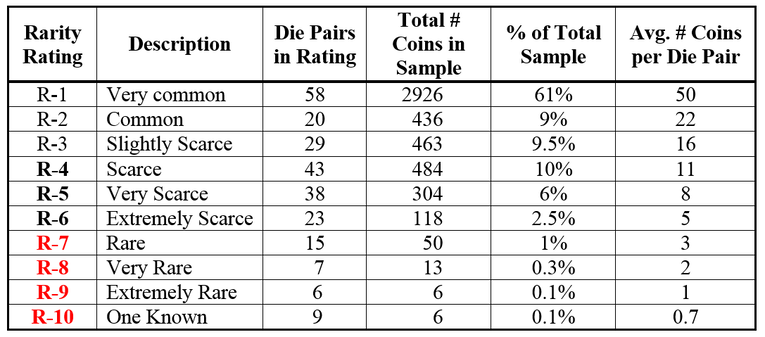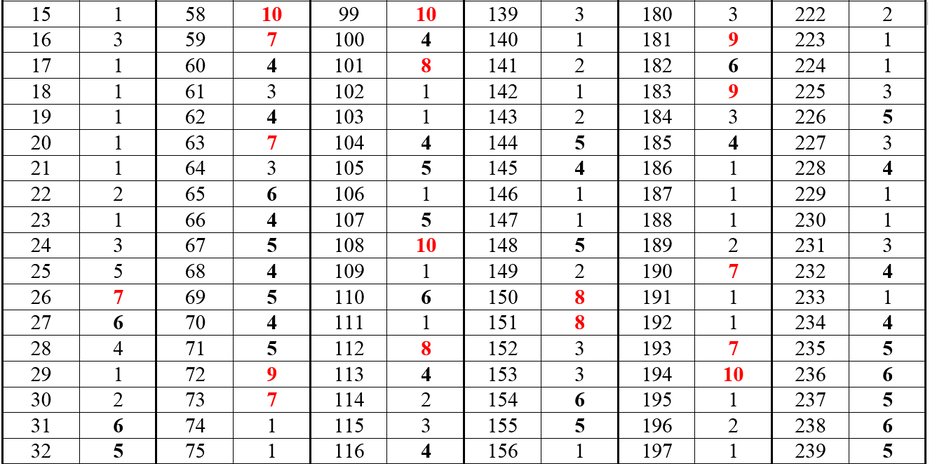The Haxby catalog of 1859 narrow 9 die pairs was first published in December of 2011. There were a few people collecting die pairs prior to the publishing of the catalog, but the information was not available to assemble a complete and organized collection until the Haxby catalog was published. Now to this we add our first attempt to publish information as to the relative rarity of the 248 known Haxby die pairs.
There are no records as to how many coins were produced by each die pair, so the only way to determine rarity is to study how easy or difficult it is to find a particular die pair. This requires looking at a large sample of coins and studying the availability of coins on the market over a period of time.
The sample of 1859 N9 coins used in this study totaled 4,806 examples of all different grades from Good to Uncirculated. The sample was compiled from collections and inventories of collectors who began accumulating die pairs even before the Haxby catalog was published. Of course, it included the collections of the authors, Randy Mason and Jim Haxby. In addition to those collections several others provided us data on their collections: Gene Belair, Doug Carlson, Marcel Gallant, Derek Lecours and Ed Reny. Thank you to all!
The table below shows the ratings we will be using where R-1 is a very common die pair and R-10 indicates a die pair for which a single example is known to us. As you can see from the table 2926 of the 4806 coins in the sample (61%) were from the 58 most common die pairs. On the other end of the scale you could combine the R-7 through R-10 ratings and only 75 of the 4806 coins in the sample (1.5%) were from the 37 rarest die pairs.
Die pairs listed as R-10 will be moved to the R-9 rating as soon as another example becomes known to us. There is a very good chance that more will be found as collectors become aware of these die pairs and begin to search for them.
Some well-known die pairs (DP9 #1, DP9 #2 and others) have been known and collected for a number of years. These die pairs tend to be over represented in the collection inventories, and we have adjusted the rarity ratings slightly to account for this.
Some die pairs which are not particularly rare can be difficult to find in higher grades and some die states are also difficult to find. We don't address either of these situations in this study.
Below is our expectation of finding a particular die pair based on this study:
The 78 die pairs listed as R-1 and R-2 are readily available and higher grade examples should not be difficult to find.
The 72 die pairs listed as R-3 and R-4 are scarcer, but with patience most of these can be found searching unattributed examples. Higher grade examples of some of these will be tougher to find.
The 61 die pairs listed as R-5 and R-6 are about twice as scarce as the R-3 and R-4 coins. Some of these also will occasionally be found in unattributed examples and finding one of these die pairs in a higher grade is a real find.
The 37 die pairs listed as R-7 through R-10 will seldom be seen in any grade and some may not be available in high grades at all. High grade examples may not have survived for some of these die pairs due to their very low mintage.
In addition to the 248 die pairs listed, there probably are a few more pairs which still await discovery. This is the real challenge and excitement for the 1859 N9 collector. Any undiscovered die pairs at this point would certainly be rare and a great find. We would very much like to know if any collector finds a new die pair so it could be included in the catalog.
The table below gives the rarity rating for all currently-known Haxby die pairs.




